A Qube! farm has 3 main components:
- The Qube! clients, machines that submit jobs. Typically these are artists or end-users workstations.
- The Qube! workers, machines that run jobs. A client can also be a worker.
- The Qube! supervisor, which controls what jobs are sent to which workers.
You will install a Supervisor, a Worker and a Client, and then submit a job from the Client to the Supervisor, which will hand it off to the Worker. All three of these roles can be played by the same machine, so if you want to investigate Qube! on a single laptop, you can do that. Or if your ambitions are larger, you can do that from here as well. Whatever your final goal, to install and start using Qube!, follow these steps.
Before You Begin
- The installer is designed to be run on a machine with a working internet connection, and we suggest saving the downloaded components to a network drive.
- You must have administration privileges to install the software.
- For Windows users, you may want to right-click > "Run as Administrator" or just log in as the Administrator.
- For Linux users, you must run as root or a sudoer.
- OS X users will be prompted to enter an admin password before installation begins.
- Once components have been downloaded, the installer can be run again on other machines without accessing the internet by pointing it to the download location used by the previous install session.
Linux Prerequisites
On linux, several packages must be present before Qube can be installed.
Linux Supervisor prerequisites:
- xinetd
- CentOS 6.x: MySQL 5.1, ships from the base repo, do not install from MySQL/Oracle yum repo
- CentOS-7.x: MariaDB 5.5, ships from base repo, do not install from MariaDB repo
Linux Worker prerequisites:
- xinetd
Linux Client prerequisites:
- < none >
Install and Go
Follow these steps:
1. Download the Install Wizard
2. Launch the Install Wizard
3. Install the Supervisor
4. Install a Worker / Client
5. Submit Test Jobs
That's it! After you've got this far, you can submit jobs for hero applications such as Maya, 3dsMax, Nuke, and many others.
More Advanced Qube Installer Usage:
Additional Possibilities
Alternatively, you can continue with Qube! administration tasks. The Administrator's Guide explains how to keep building up your Qube! installation, including:
Installing Licenses
Adding Additional Workers
Adding Additional Clients
Tuning Qube! for Optimal Performance
2. Launch the Install Wizard
Windows
Extract the contents of the installer zip file. Go into the folder created, right mouse click on the installer file, and run as administrator.
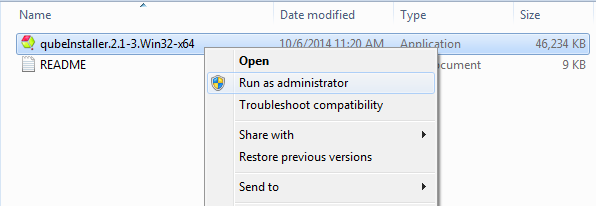
OS X
Double-click on the dmg file that you downloaded. You should see this:
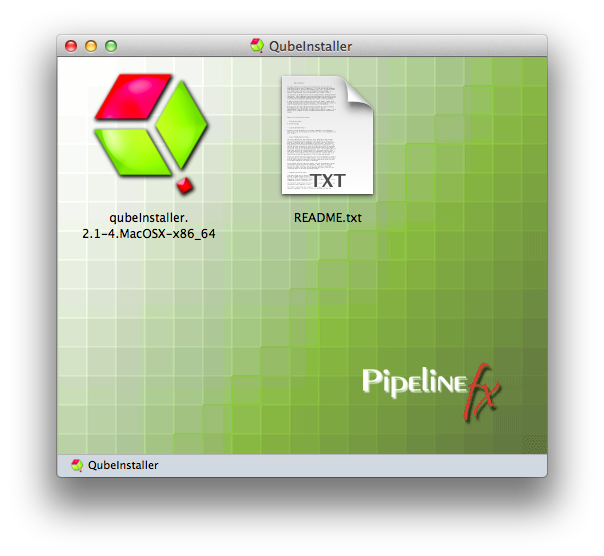
Then double-click on the qubeInstaller icon.
Linux
For Linux, the steps are:
$ cd /path/to/downloaded/installer
$ tar xvzf qubeInstaller.CentOS_6.5.x86_64.tgz # Note: of course the file name may differ depending on your Linux distribution
$ cd qubeInstaller-2.1-2.CentOS_6.5.x86 # move into the directory that was just created
$ sudo ./qubeInstaller.2.1-2.CentOS_6.5 # run the installer with sudo or as root
All OSs
In all cases, you will now see the opening screen, followed by a license agreement, which you should read and accept before continuing. Note: Depending on your OS, the installer screens may look slightly different, but the content will be exactly the same.


You will then see a screen which is asking where the packages to be installed will come from. The default is to download them from the PipelineFX repository, and you should leave this screen at its default and hit 'Continue'. You will then be asked for a location to download the software to. You can choose anywhere, but in general you will want these packages stored in a location that is visible to all machines on the network. For simple installs or evaluations, you can just choose your local Downloads directory, as shown here.
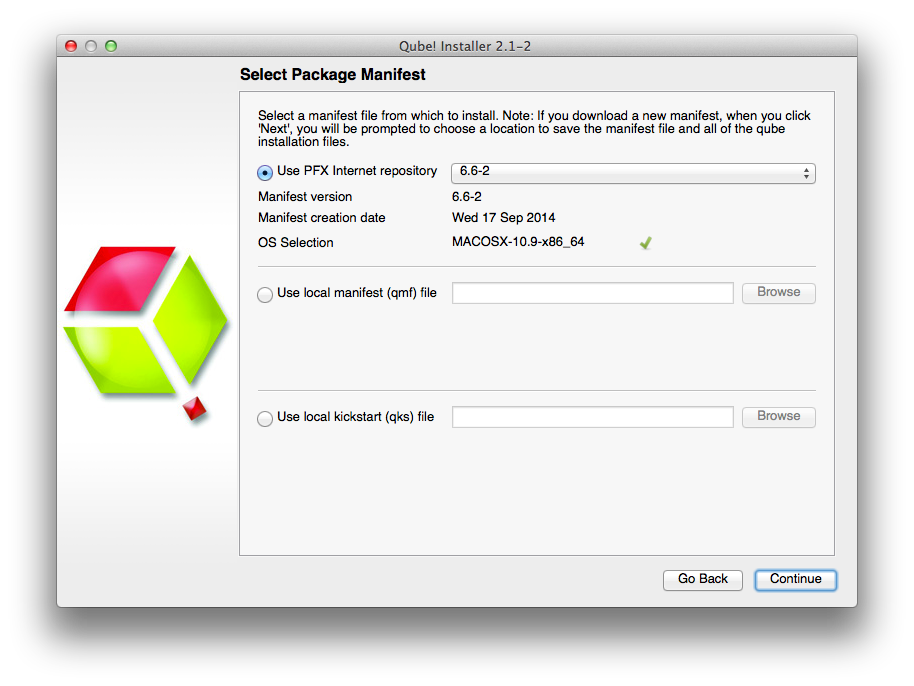

At this point you are ready to install one of the Qube! components. If this is your first install, keep reading and install a Supervisor. Otherwise, skip that and move to installing a Worker and Client, below
3. Install the Supervisor
The Supervisor controls and monitors the jobs that the Clients send to the Workers. There should be only one Supervisor on your network. For evaluation purposes, the Supervisor can be almost any machine, but for production use you should refer to the Supervisor guidelines on the System Requirements page.
If you have been following the installer steps above, you should now be looking at the Component Selection page, shown below. Click on 'Supervisor' as shown here:

The install wizard will look to make sure there isn't already a Supervisor installed on this network / subnet, and then it will allow you to click through to install the Supervisor. First it will download the additional components, and then it will install them. You should end up with this screen:
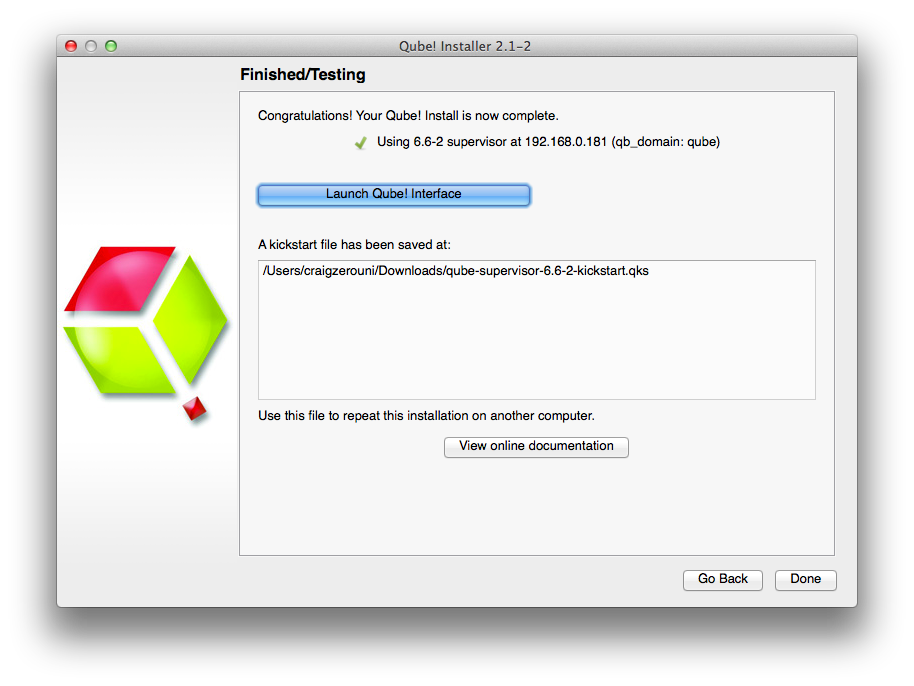
You can launch the Qube! Wrangler GUI from here if you like, but let's keep going and finish the install. So click through to the end and exit the install wizard. But continue following the instructions on this page. If you are installing on Windows, at this point you will see a desktop icon for Qube! WranglerView.
4. Install a Worker & Client
What's the difference between a Worker and a Client? A Worker is going to render frames or run simulations or do whatever tasks you want to submit. You want one of those on every machine that you expect to be able to pick up and execute a task.
A Client is a machine or interface that a person submits jobs from. Installing a Client really just means installing the User UI, which is a simpler version of the Wrangler UI. In that sense, it is optional - users can also submit from, and monitor their jobs from, the Wrangler UI.
User's desktop machines tend to be both Workers and Clients, so in that case you would install both. In a larger installation, there would be a lot of Workers and relatively fewer Clients. There is more detail on the Terminology page.
To do the install, we are assuming you already have a Supervisor installed on the network/subnet. You can install the Worker and Client on a different computer, or if you want to do a simple evaluation of Qube!, on the same one you just used for the Supervisor. If it is a different computer, it can have a different OS from the Supervisor - but if it does, you will need to go back to Step 1 and download the appropriate installer for the Worker / Client OS.
For the purposes of this Quickstart, we are going to install both Worker and Client at the same time on the same machine. Launch the installer again, and click through to the Component Selection screen. This time, select Worker, and then also click on the checkbox labeled "Qube! ArtistView":
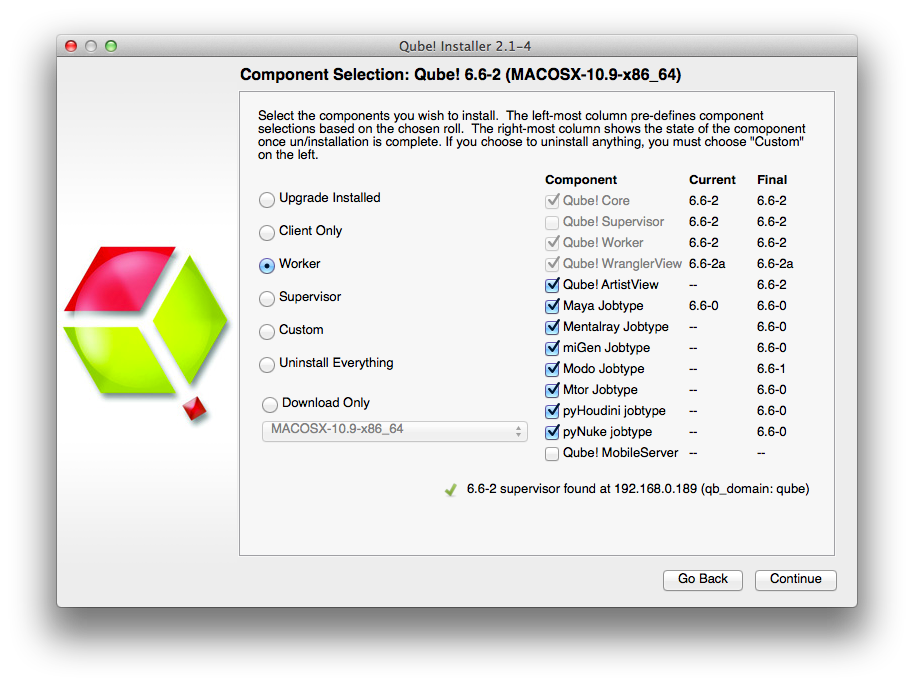
Next, you will be asked which 'mode' to run the Worker in, with a dialog like this:
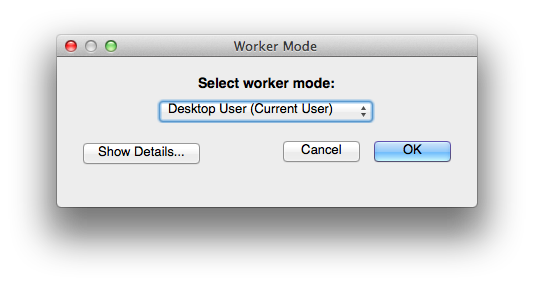
For now, choose the default, which is Desktop User mode. There is an explanation of what this means, and what mode you might want in various environments, on this page.
Again, the installer will download the selected components, and then install them. When this completes, you will see buttons allowing you to submit some test jobs. We'll do that in the next section. So keep reading...
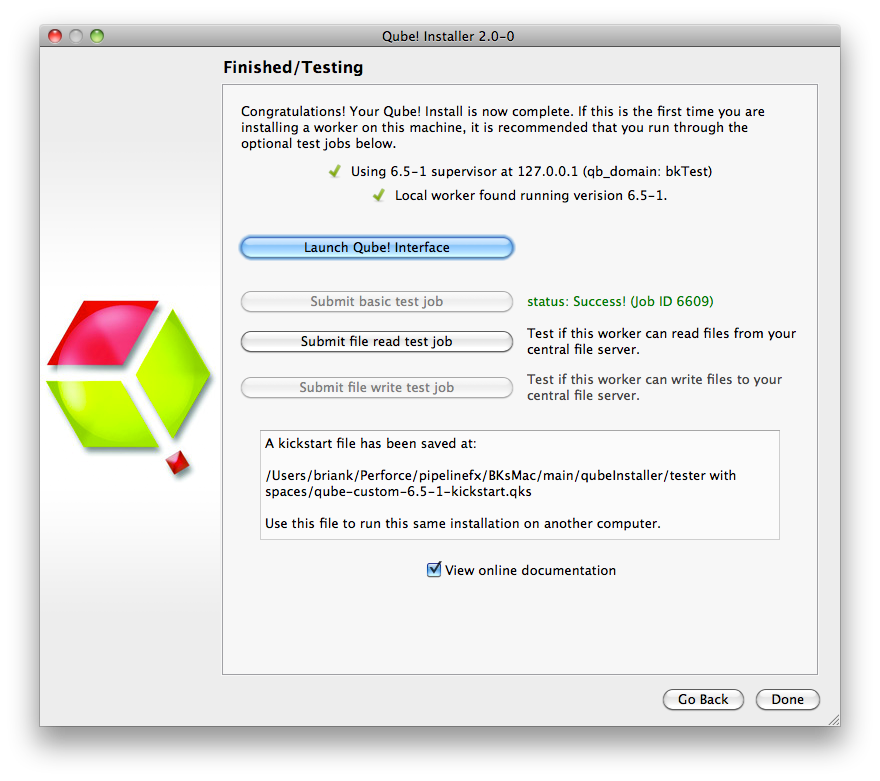
5. Submit Basic Test Jobs
We assume you have a dialogue box on your screen similar to the above. To verify that the Qube! Supervisor is running and that the Worker and Supervisor can see each other, click on "Submit basic test job". You should see it change to "Pending" and then "Running" and finally "Success!"
Now click on "Submit file read test job". This will pop up a dialogue box. You should choose a file that is accessible to both Worker and Supervisor, typically on a mounted network drive. If you are testing Qube! such that the Worker and the Supervisor are on the same machine, then you can choose a local file.

You should then seen the same "Pending", "Running" and "Success!" messages.
At this point, exit the installer. Then launch the Qube! Wrangler View. On Windows, it will be the red & green desktop icon. On OS X, it will be in Applications/pfx/qube. On Linux you type 'qube'. You should see this UI:
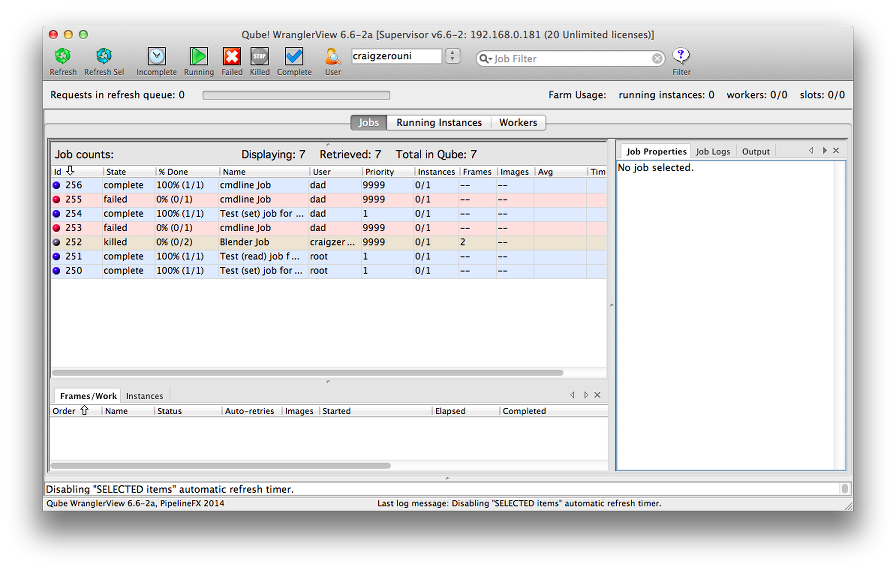
Let's use this to launch a quick commandline job, just to see how this works. From the menu bar, choose Submit -> Cmdline Job.
You'll get this UI. Fill in the command with something like the command shown (Linux & OS X):

For Windows, the commands could be this:

Then click on Submit and refresh the Wrangler view. You should see your job pick up, run and complete. The output from the commands you typed in the box will be in the right pane, under Job Logs / Stdout Log. Notice that the job runs as the user you are logged in as, while the test jobs you submitted from the installer were run as root (except on Windows, where they will still run as the person using the installer).
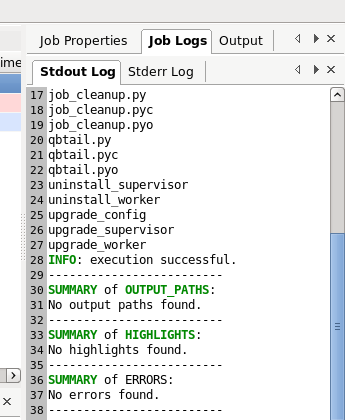
At this point, your supervisor and worker are up and going. You can install more workers and/or clients by using the installer again, or by using the kickstart files. You can find help with submitting specific kinds of jobs, for example Maya or After Effects, in the Submitting Jobs section.
Licensing
At this point, Qube! is running 2 evaluation licenses (these are Designer licenses, which will only allow one job to run on a worker at a time). You can use these licenses to evaluate Qube! indefinitely, but if you want to run more Workers you will need to purchase licenses for them. Instructions for installing additional licenses are on the License Installation page.